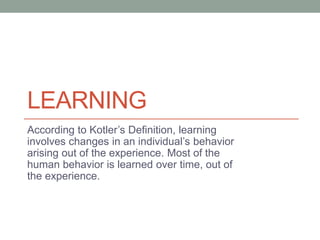M4.pptx
•Descargar como PPTX, PDF•
0 recomendaciones•4 vistas
CONSUMER BEHAVIOUR
Denunciar
Compartir
Denunciar
Compartir

Recomendados
Recomendados
Más contenido relacionado
Similar a M4.pptx
Similar a M4.pptx (20)
Cb unit-vi (psychological influences on consumer decision making)

Cb unit-vi (psychological influences on consumer decision making)
Consumer Learning the meaning and types in consumer behaviour

Consumer Learning the meaning and types in consumer behaviour
Más de MANASA759282
Más de MANASA759282 (20)
The relationship bw culture and service quality perception. Based on the Cros...

The relationship bw culture and service quality perception. Based on the Cros...
Group 4_Evolution of Entrprenurial Thought (1).pptx

Group 4_Evolution of Entrprenurial Thought (1).pptx
Group 5_Modern Management Thought- Systems School .pptx

Group 5_Modern Management Thought- Systems School .pptx
Último
Último (20)
Call Girls in Delhi, Escort Service Available 24x7 in Delhi 959961-/-3876

Call Girls in Delhi, Escort Service Available 24x7 in Delhi 959961-/-3876
Quick Doctor In Kuwait +2773`7758`557 Kuwait Doha Qatar Dubai Abu Dhabi Sharj...

Quick Doctor In Kuwait +2773`7758`557 Kuwait Doha Qatar Dubai Abu Dhabi Sharj...
Call Girls Kengeri Satellite Town Just Call 👗 7737669865 👗 Top Class Call Gir...

Call Girls Kengeri Satellite Town Just Call 👗 7737669865 👗 Top Class Call Gir...
Russian Call Girls In Gurgaon ❤️8448577510 ⊹Best Escorts Service In 24/7 Delh...

Russian Call Girls In Gurgaon ❤️8448577510 ⊹Best Escorts Service In 24/7 Delh...
Call Girls Service In Old Town Dubai ((0551707352)) Old Town Dubai Call Girl ...

Call Girls Service In Old Town Dubai ((0551707352)) Old Town Dubai Call Girl ...
Call Girls Ludhiana Just Call 98765-12871 Top Class Call Girl Service Available

Call Girls Ludhiana Just Call 98765-12871 Top Class Call Girl Service Available
Value Proposition canvas- Customer needs and pains

Value Proposition canvas- Customer needs and pains
Insurers' journeys to build a mastery in the IoT usage

Insurers' journeys to build a mastery in the IoT usage
Enhancing and Restoring Safety & Quality Cultures - Dave Litwiller - May 2024...

Enhancing and Restoring Safety & Quality Cultures - Dave Litwiller - May 2024...
How to Get Started in Social Media for Art League City

How to Get Started in Social Media for Art League City
Falcon's Invoice Discounting: Your Path to Prosperity

Falcon's Invoice Discounting: Your Path to Prosperity
Call Girls Hebbal Just Call 👗 7737669865 👗 Top Class Call Girl Service Bangalore

Call Girls Hebbal Just Call 👗 7737669865 👗 Top Class Call Girl Service Bangalore
FULL ENJOY Call Girls In Majnu Ka Tilla, Delhi Contact Us 8377877756

FULL ENJOY Call Girls In Majnu Ka Tilla, Delhi Contact Us 8377877756
BAGALUR CALL GIRL IN 98274*61493 ❤CALL GIRLS IN ESCORT SERVICE❤CALL GIRL

BAGALUR CALL GIRL IN 98274*61493 ❤CALL GIRLS IN ESCORT SERVICE❤CALL GIRL
M4.pptx
- 1. LEARNING According to Kotler’s Definition, learning involves changes in an individual’s behavior arising out of the experience. Most of the human behavior is learned over time, out of the experience.
- 2. Elements of Consumer Learning • Motivation • Cues • Response • Reinforcement
- 4. MARKETING APPLICATION OF CLASSICAL CONDITIONING • Repetition • Stimulus Generalization • Stimulus Discrimination
- 6. INSTRUMENTAL CONDITIONING • In Instrumental Conditioning, the stimulus that results in the most satisfactory response is the one that is learned. • In consumer behavior terms, it suggests that consumers learn by trial and error process in which some purchase behaviours results in more favourable outcomes (i.e., rewards) than other purchase behaviours. A favourable experience is “instrumental” in teaching the individual to repeat a specific behavior.
- 8. CONSEQUENCES OF OPERANT CONDITIONING • Positive Reinforcement • Negative Reinforcement • Forgetting and Extinction
- 9. Strategic/Marketing applications of instrumental conditioning • Customer Satisfaction (Reinforcement) • Relationship Marketing • Reward
- 10. Cognitive learning theory: Neo-Pavlovian Model • A considerable amount of learning takes place as a result of consumer thinking and problem solving.
- 12. How Consumers Store, Retain, and Retrieve Information • The structure of memory Sensory store Short-term store Long-term store • Rehearsal and encoding • Information overload • Retention
- 13. MODELING OR OBSERVATIONAL LEARNING: - • “It is a process by which individuals observe the behavior of others, and consequences of such behavior.
- 14. INVOLVEMENT THEORY There are four general CIT categories: • High involvement / emotional • High involvement / rational • Low involvement / emotional • Low involvement / rational